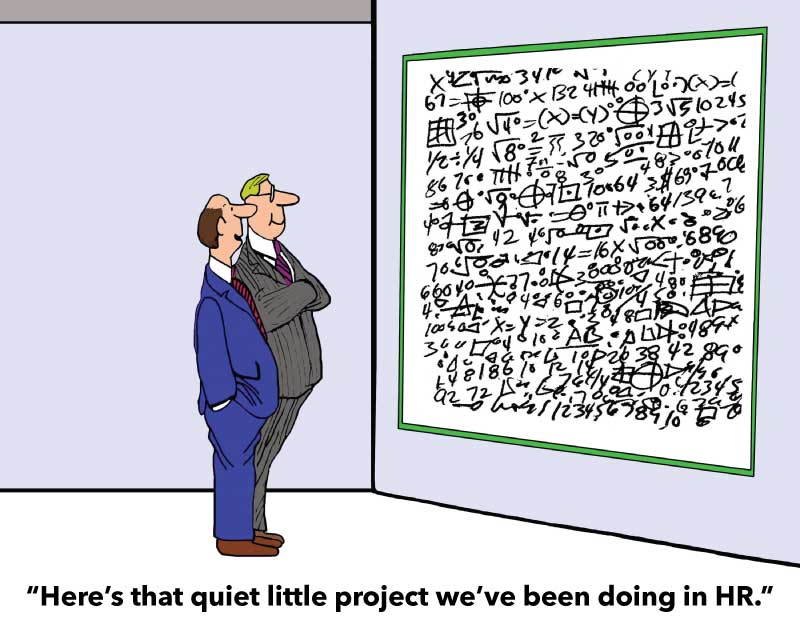Not all HR analytics projects succeed. Some never really get off the ground, others don’t produce tangible results and some even lead to internal conflict.
Erik van Vulpen is the founder of Analytics in HR Consultancy & Support. He is an expert in connecting HR processes to business results through qualitative and quantitative. He and his team compiled a list of the 5 most important reasons why analytics projects fail.
This list will help you succeed in yours.
The HR analytics project is too ambitious
It is easy to get excited when you start with an HR analytics project – but don’t fall in the trap of becoming over-excited. A grand vision and high ambitions are required to get HR analytics off the ground, but they should not apply to the first few projects. Often companies bit off more than they can chew and end up getting stuck in analytics projects that are too large to manage. These analytics projects can take years before they complete, cost tremendous amounts of money and produce results that are not relevant anymore.
Especially early on, the HR analytics project leader should plan for andcreate short-term wins. These short-term wins are the simplest and quickest analysis which require the least amount of data but add the best value to the company.
These wins are very important, because they enable the team to learn and work together more effectively, while increasing the visibility of the HR analytics project throughout the organization. As some people tend to be skeptical about HR analytics, it is important to demonstrate its value early on in the project by presenting these short-term wins.

The development of analytical competencies and increased visibility are pivotal in establishing HR analytics as a competency center within the organization and therefore reinforce the importance of short-term wins. A side effect is that it will also increase interest from middle and senior management throughout the company. In turn, this will expedite the implementation of the project’s outcomes.
Lack of relevance to the business
A second trap, which may be just as common as the first one, is a lack of relevance to the business. It is not uncommon for an analytics project to focus on an interesting topic which doesn’t actually add value to the business.
Attrition analytics is one of the most talked about examples of HR analytics and is a starting point for many HR analytics projects. However, when attrition is not a core business problem, the results of the analysis do not add value to the business.
A good rule of thumb is to focus on one of the top 3 business priorities of the CEO. The CEO is not concerned about the number of employees he has or about the latest engagement scores. He is concerned about whether he has the right people with the right skills to execute the company’s strategy, and he wants to know how he can increase his revenue while minimizing costs.
Only by focusing on a top business priority will HR analytics provide tangible value.
Compliance was not looped in from the beginning
Compliancy is becoming increasingly important. The HR analytics project has to be tailored based on both the internal company policies and the external, (trans)national regulations. Industries like banks and hospitals have strict internal policies on how data should and should not be exchanged and/or analyzed. In addition, national and European laws are becoming increasingly strict on how to handle data (e.g. the Reform of EU data protection rules and the EU-US Privacy Shield are recent examples).
It is not uncommon for HR to discover that they cannot gain access to email or social network data, or fail to gain access to individual employee survey data because the employees were promised full anonymity. Involving compliancy early on in the project will increase the chances of a project’s success and prevents the investment of time and resources on HR analytics projects that were doomed to fail from the start.
Bad data
A fourth reason why HR analytics projects fail is bad and messy data. It is commonly known that HR data is not the most pristine: unlike finance the numbers never need to add up perfectly. It is not rare for things like function or department names to be mislabelled or abbreviated in different ways. In addition, there are often messy records of promotions and previous functions within the same company, if at all, which makes it hard to track employment history.
Bad data can make a project fail in two major ways. Firstly, the analysis can become distorted when data is mislabeled; e.g., one job type could be analyzed as two different jobs due to a typo. A common saying in data analytics is “garbage in, garbage out” – which means that poor quality of input always produces erroneous output.
Secondly, cleaning the data is a very time-consuming process and can take months or even years. Bigger firms like multinationals sometimes use different software systems in different countries, and use different data (entry) procedures between those countries. Add cultural differences on topics like performance appraisal to the mix, and you run the risk of comparing apples to oranges. Especially in these situations focusing on smaller HR analytics projects with short-term wins is especially relevant as they require less data cleaning.
No translation to actionable insights
Our final pitfall is a lack of translation to actionable insights. HR analytics may produce some very interesting findings about a top business problem. However, these insights hold no value when it’s impossible to take action.
For example, it’s very hard to change things like an employee’s sex or age. These variables are interesting and should be included in an analysis as control variables, but they cannot easily be manipulated (i.e. you cannot change sex).
Other attributes, like engagement, can be influenced through various interventions. It is therefore much more useful to see how engagement levels impact bottom line performance than to see how sex impacts turnover intentions.
Of course it is interesting to know how sex impacts turnover intentions, but you cannot act on this insight. What is interesting is WHY sex would impact one’s turnover intentions – and of course what you can do to influence these reasons.
Focusing on the actionability of your data and outcomes is important in order to come up with solutions that people can work with and implement to make better people decisions.
HR analytics offers many possibilities – but it is still a novel approach for a lot of companies and projects are therefore prone to fail. By focusing on top business priorities, by including compliancy early on and by planning quick wins, an HR analytics project can greatly improve its chances of success. The quick wins are important, because they force the project team to define a specific question whose answer doesn’t require huge amounts of data (cleaning), yet also boosts the team’s morale and visibility within the organization.


